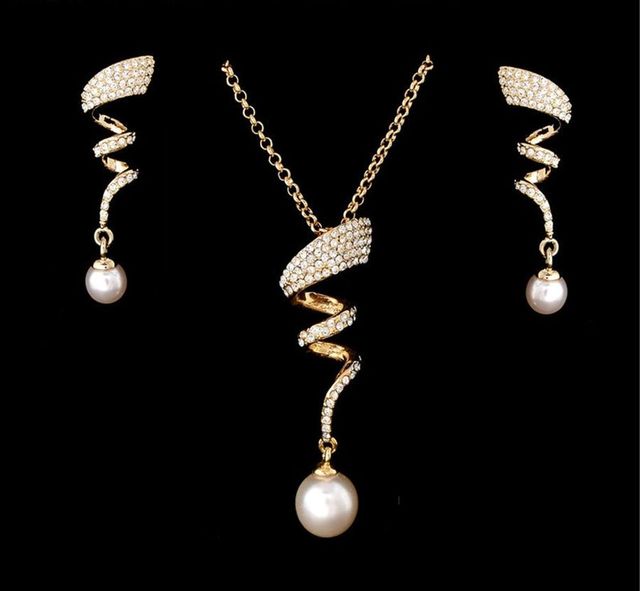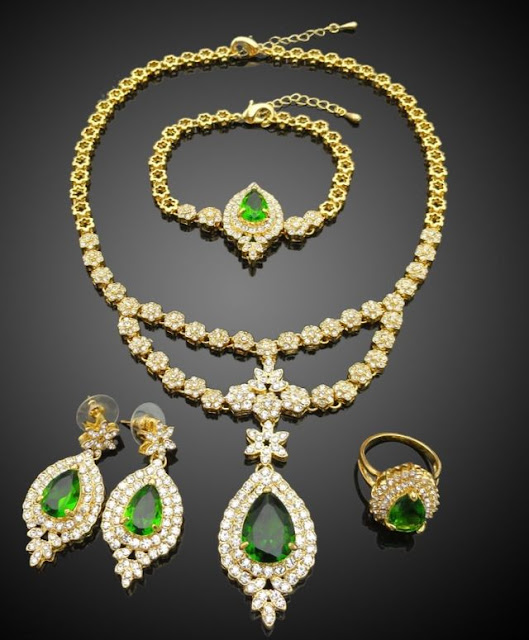Shopping for Different Types of Fashion Jewelry
Fashion jewelry was originally conceived as low-cost accessories that reflected the fashion trends of the period. With its inexpensive nature, fashion jewelry, also known as costume jewelry, was designed to be disposable as new styles emerged. For women without the resources to acquire large collections of fine jewelry or heirloom pieces, fashion jewelry provided the means to feel glamorous and dress up everyday outfits without making a hefty investment.

Although costume jewelry has been prevalent throughout the 20th century, its status gradually shifted during the 1940s as innovative designers like Coco Chanel and Christian Dior began crafting higher quality pieces popularized by Hollywood movie stars. Fashion jewelry has evolved to become a staple of modern jewelry collections, regardless of wealth or social class. Such jewelry no longer functions purely as throwaway accessories but may be preserved and kept for years depending on the quality.
Fashion jewelry varies in both price and craftsmanship. The vast price difference makes it easy for any woman to fit fashion jewelry into her budget, but it also opens the door to poorly made pieces. When shopping for costume jewelry, always keep clothing and the occasion in mind. Pieces designed for everyday, casual style are often made from basic metals, plastic, and other lightweight materials. Look for decorative details that are painted on, instead of carved or inlaid. Lower end jewelry manufacturers also reduce costs by gluing pieces together and coating the surfaces with thin foil-like plating that easily scratches away. Expensive fashion jewelry can convincingly replicate the appearance of fine jewelry by mixing higher grade materials with inexpensive ones. For example, a diamond necklace may have a real sterling silver chain but substitute cubic zirconia for the stone. Stones set into jewelry by sturdy prongs and gemstones that are difficult to distinguish from genuine varieties are signs of higher quality. Being able to tell the difference is essential when mixing and matching jewelry because accessories of similar craftsmanship contribute to a unified appearance. In formal settings, fashion jewelry is intended to subtly elevate an outfit without calling attention to the monetary value of the piece, which can be ruined by a single garish accessory.
Balancing Fashion Jewelry Combinations
Achieve balance by making different jewelry pieces complement one another, instead of competing for attention. Layering is useful for adding dimension and contrast to an outfit, but too many pieces translate as heavy and messy, detracting from the wearer and the clothes. Avoid wearing several accessories of different types in close proximity by selecting a focal point. An elaborate necklace pairs well with simple rings because the pieces are far apart - on the neck and hand - and won't overpower each other. Similar to other art forms, fashion depends on the canvas.

Body type contributes to the overall effect jewelry has on someone's appearance. For example, a full-figured woman benefits from wearing bigger accessories that are proportionate to her physical characteristics. On the other hand, oversized jewelry can overwhelm a petite person's appearance and take away from natural attributes. The same rules hold true for clothing. Busy patterns with big, bold details are tastefully offset by simple jewelry in muted tones, and solid fabrics place emphasis on ornate accessories.
Size and Quantity
Pay attention to size and quantity when mixing and matching fashion jewelry. Piling on several pieces of large jewelry creates bulk and sends the message that the wearer's look is random and unintentional. More jewelry on one part of the body should equal less in another area, including wearing bracelets on both arms. Balance an armful of bangles with a bare wrist. Avoid wearing more than one jewelry piece with oversized faux gemstones, and in general, limit the overall quantity of jewelry in an outfit during formal occasions.
Bracelets
- One Arm - Create a cuff effect with a column of thin bangles or aim for contrast with one or two wide bracelets separated by groups of thinner bangles.
- Two Arms - Avoid overload by confining bracelets to a small stretch of wrist, such as one inch. Wear bracelets of roughly the same size or amount to create a semi-symmetrical look.
Rings
- Multiple on same hand - Commit to no more than three rings and choose jewelry with contrasting styles and textures. Rings with large stones or decorative shapes work well next to single and double bands without stones as well as abstract bands molded into non-traditional shapes such as leaves and animals. A multi-finger ring that shares a single decoration is a simple way to accessorize the entire hand without clashing styles.
- Multiple on different hands - Wearing several rings on both hands is a common trend with a delicate balance. Avoid multiple large stones or decorations that create overcrowding. Rings with raised decorations are offset by smooth surfaces and low settings. Find jewelry of similar length or slightly shorter where necessary, such as rings with decorations stretching from the knuckle to the first bend of the finger.
Earrings
- Multiple Holes - Earrings should decrease in size moving away from the earlobe. Wear no more than two different styles, and make sure the chosen styles are complementary. For example, pair hoops or chandelier earrings with studs. Multiple hoops in the same shape can be worn in different sizes, but avoid wearing multiples of other large decorative earrings.
Necklaces
- Size - Drastic size differences create an eye-catching contrast. A necklace with giant oversized beads is offset by small- and medium-sized beads. Another option is to create a neckpiece of single-sized beaded necklaces with slightly varying lengths from the neck to just above the cleavage.
- Length - Create elegant lines along the neck and torso by varying the lengths of necklaces. One choker or short strand of pearls works well with one or two necklaces that end just above or below the bust line and one or two longer pieces that hang a few inches above the navel.
- Style - Avoid a one-dimensional look by pairing different styles, such as mixing beads or pearls with chains. Chains, pearls, and round beads are useful for adding more without taking attention away from focal points like pendants and gemstone-covered necklaces.
Material and Texture
Natural and industrial styles can coexist peacefully in fashion. Necklaces and bracelets offer the ideal opportunity to blend wood, leather, and metal materials, juxtaposing the shiny or brushed texture of metal with the rich grain of wood or hide. In most cases, sticking to one metal prevents confusion; however, two-toned jewelry or varying shades of brass and bronze are stylish exceptions. Mixed metals should follow a logical pattern. Instead of randomly arranging gold and silver bangles, separate the colors into alternating mini groups of two or three bracelets. Earring arrangements are more effective with uniformity. Changing up the shape and style works fine, but varying the metal results in a mismatched look.

When it comes to bracelets and necklaces, color directs the arrangement more than material or texture. If the basic color scheme is preserved, metals, wood, beads, gemstones, and other styles can easily be mixed and matched. Pairing similar attributes such as luster or shape can produce an attractive piece, such as shiny gemstones and shiny beads. With or without a textural focal point, necklace and bracelet arrangements come to life with a creative progression of contrasting shapes and bead sizes. Pearls can work right alongside pale gold chains, crystal beads, and a long brooch-inspired pendant.
Color
Color is the element that holds mix-and-match jewelry looks together. Not only does color influence how accessory pieces work together, but most suitable color schemes are determined by the skin tone of each individual. Warm colors include red, yellow, orange, and derivative hues with a high concentration of these colors, such as magenta and lime green. Cool colors include blue, green, violet, and other similar derivative colors, such as turquoise and indigo.
Every primary color has a direct complement and supplementary hues that balance naturally with it. For example, red and turquoise are frequently combined in fashion editorials because the latter color is derived from a natural complement of red - blue-green. Focus on pairing bold colors with muted complementary colors, such as pale gold bangles, gold-tinted pearls, and violet gemstones. White, black, and silver jewelry fit neutrally into almost any arrangement, making them versatile pieces to own.
Primary |
Complementary |
Supplementary |
|---|---|---|
| Red | Green | Blue-green and yellow-green |
| Yellow | Violet | Blue-violet and red-violet |
| Blue | Orange | Yellow-orange and red-orange |
Fashion jewelry is a low-maintenance way to dress stylishly for work, special occasions, and casual outings. For most pieces, the cost is logically proportionate to the craftsmanship and materials, and frequent upkeep is unnecessary. Mixing and matching fashion jewelry creates a wider range of day-to-day looks and counteracts lost accessories by allowing the owner to continue pairing pieces with other jewelry. By making small modifications in the balance of color, material, style, and size, jewelry owners can design distinct arrangements that specifically complement their body type, skin tone, and personality.



No comments:
Post a Comment